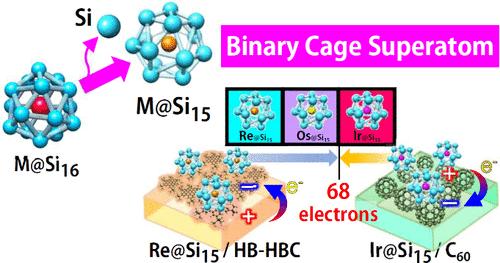当前位置:
X-MOL 学术
›
J. Phys. Chem. Lett.
›
论文详情
Our official English website, www.x-mol.net, welcomes your
feedback! (Note: you will need to create a separate account there.)
Tailoring Superatomic Stability with Transition Metals in Silicon Cages: Shrinking to M@Si15 (M = Re, Os, Ir)
The Journal of Physical Chemistry Letters ( IF 4.8 ) Pub Date : 2024-11-14 , DOI: 10.1021/acs.jpclett.4c02797 Takumi Ichikawa, Kazuya Terasaka, Ayaka Sasaki, Atsushi Nakajima
The Journal of Physical Chemistry Letters ( IF 4.8 ) Pub Date : 2024-11-14 , DOI: 10.1021/acs.jpclett.4c02797 Takumi Ichikawa, Kazuya Terasaka, Ayaka Sasaki, Atsushi Nakajima

|
The design of materials with intriguing electronic properties is crucial for advancing nanoscale technologies, where precise control over atomic structure and electronic behavior is essential. Metal-encapsulating silicon cage superatoms (SAs) provide a new paradigm for molecular-scale material design, allowing fine-tuning of both structure and electronic characteristics. The formation of superatoms mimicking halogens, noble gases, and alkali metals has been well-studied, particularly with M@Si16, where early transition metals from groups 3 to 5 stabilize within a Si16 cage, achieving a 68-electron configuration. For late transition metals with excess electrons, a Si15 cage offers enhanced stability by fulfilling the 68-electron rule with one fewer Si atom. This research synthesizes Si15 cage-SAs with rhenium (Re) from group 7 and iridium (Ir) from group 9 on p-type and n-type organic substrates. The stability of Re@Si15 and Ir@Si15 is evaluated via oxidative reactivity with X-ray photoelectron spectroscopy and theoretical calculations, including osmium (Os) from group 8. Re@Si15–, Os@Si150, and Ir@Si15+ exhibit superatomic behaviors similar to halogens, noble gases, and alkali metals due to the 68-electron shell closure. Among them, Re@Si15– on p-type organic substrates shows superior electronic and geometric properties. These findings advance our understanding of M@Sin systems for transition metals, addressing longstanding questions about their properties at n = 15 and 16.
中文翻译:

使用硅笼中的过渡金属定制超原子稳定性:收缩至 M@Si15 (M = Re, Os, Ir)
设计具有有趣电子特性的材料对于推进纳米级技术至关重要,其中对原子结构和电子行为的精确控制至关重要。金属封装硅笼超原子 (SA) 为分子尺度材料设计提供了一种新的范式,允许对结构和电子特性进行微调。模拟卤素、惰性气体和碱金属的超原子的形成已经得到了很好的研究,特别是 M@Si16,其中第 3 族至第 5 族的早期过渡金属稳定在 Si16 笼内,实现 68 电子构型。对于具有多余电子的晚期过渡金属,Si15 笼通过少一个 Si 原子来实现 68 电子规则,从而提供更高的稳定性。本研究在 p 型和 n 型有机衬底上合成了第 7 族的铼 (Re) 和第 9 族的铱 (Ir) 的 Si15 笼式 SAs。Re@Si15 和 Ir@Si15 的稳定性通过与 X 射线光电子能谱的氧化反应性和理论计算来评估,包括第 8 族的锇 (Os)。由于 68 电子壳层闭合,Re@Si15–、Os@Si150 和 Ir@Si15+ 表现出类似于卤素、惰性气体和碱金属的超原子行为。其中,Re@Si15– 在 p 型有机衬底上表现出优异的电子和几何性能。这些发现促进了我们对过渡金属 M@Sin 系统的理解,解决了长期以来关于它们在 n = 15 和 16 时的性能的问题。
更新日期:2024-11-14
中文翻译:

使用硅笼中的过渡金属定制超原子稳定性:收缩至 M@Si15 (M = Re, Os, Ir)
设计具有有趣电子特性的材料对于推进纳米级技术至关重要,其中对原子结构和电子行为的精确控制至关重要。金属封装硅笼超原子 (SA) 为分子尺度材料设计提供了一种新的范式,允许对结构和电子特性进行微调。模拟卤素、惰性气体和碱金属的超原子的形成已经得到了很好的研究,特别是 M@Si16,其中第 3 族至第 5 族的早期过渡金属稳定在 Si16 笼内,实现 68 电子构型。对于具有多余电子的晚期过渡金属,Si15 笼通过少一个 Si 原子来实现 68 电子规则,从而提供更高的稳定性。本研究在 p 型和 n 型有机衬底上合成了第 7 族的铼 (Re) 和第 9 族的铱 (Ir) 的 Si15 笼式 SAs。Re@Si15 和 Ir@Si15 的稳定性通过与 X 射线光电子能谱的氧化反应性和理论计算来评估,包括第 8 族的锇 (Os)。由于 68 电子壳层闭合,Re@Si15–、Os@Si150 和 Ir@Si15+ 表现出类似于卤素、惰性气体和碱金属的超原子行为。其中,Re@Si15– 在 p 型有机衬底上表现出优异的电子和几何性能。这些发现促进了我们对过渡金属 M@Sin 系统的理解,解决了长期以来关于它们在 n = 15 和 16 时的性能的问题。


















































 京公网安备 11010802027423号
京公网安备 11010802027423号